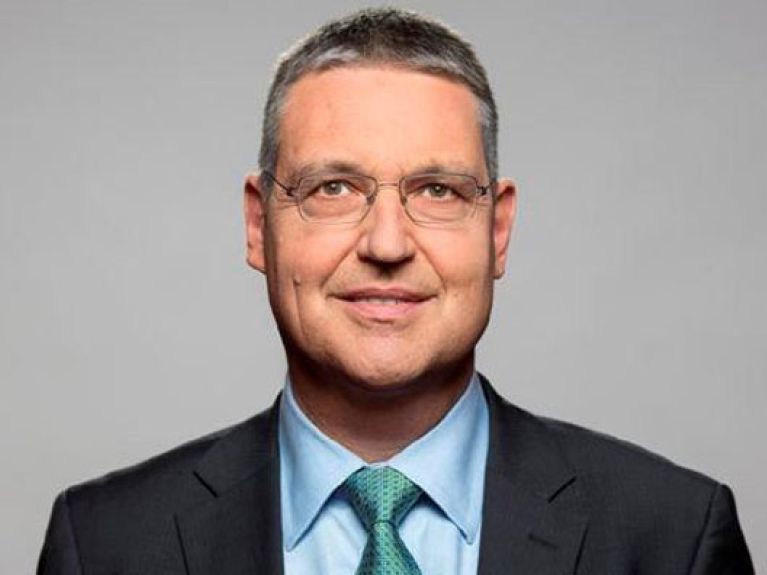Mediation and Diplomacy
An interview with Dr. Markus Ederer, State Secretary of the German Federal Foreign Office, about mediation in German foreign policy.

Dr. Ederer, you are taking part in the “Mediation and Diplomacy” peer coaching scheme by the Centre for International Peace Operations. What role does mediation play in German diplomacy?
Mediation plays an immense role in German diplomacy - sometimes a visible, sometimes an invisible one. Take Germany’s prominent role in the conflicts between Ukraine and Russia. Admittedly, we have specifically established and expanded the area of crisis prevention and reinforcing peace, including mediation. But as I see it not every good diplomat is necessarily also a good mediator. That requires special techniques and skills. Which is why, and owing to the increasingly important role of mediation in a growing number of international conflicts, we are running this peer coaching scheme. And naturally I was also happy to make the time to take part in the event. The aim is to learn from successful and unsuccessful mediation efforts. In addition, I hope to get some valuable ideas for training our prospective mediators. Knowing what advice to give young diplomats so that they are in a position to use mediation in their daily work is a topical issue, and of great importance for us. Which is why I’m so delighted that we were able in cooperation with the Centre for International Peace Operations (zif) to organise this coaching.
Can you give us a few specific and successful examples of it – say in relation to German Chairmanship of the OSCE 2016?
The OSCE is and remains a key instrument of conflict prevention and conflict resolution in Europe. This is evidenced in the conflicts in Ukraine and the Republic of Moldova. Negotiations to solve the conflict in Moldova have been in place since 1993. A so-called 5+2 format has developed, to which Moldova and Transdniestria but also Russia, Ukraine, and the OSCE as mediator, but also the European Union and the United States belong as observers. Following the lack of progress in 2012, two years ago negotiations ground to a halt altogether. This prompted the revival of the 5+2 talks in Berlin on 2/3 June (this year). Here our strategy is through confidence-building measures to achieve progress that benefits people on both sides of the river Dniester, for example in the fields of education and transport, where negotiations have intensified again. Since 2010 on German initiative we have in the framework of so-called “track 2” negotiations, every year brought together representatives of the conflict parties in a relaxed setting in Bavaria. This year there was another conference on confidence building measures to further the negotiation process, while the revived 5+2 talks took place in Bad Reichenhall.
Whether something is successful or not is always also a question of perspective. The Minsk roadmap was in itself a success, since it provided a way out of the crisis and put a stop to the imminent all-out war between two states. Nonetheless, people die almost every day in East Ukraine. What I am saying is that anyone who ventures mediation must also be able to withstand setbacks, and be prepared to repeatedly take fresh and creative starts.
What is on the agenda of the Conference, how many and what high-ranking participants do you expect, and what is the aim of the peer coaching scheme?
For the peer coaching scheme we want to look at the pre-requisites for successful mediation and examine specific case studies. For instance, we want to look at the mediation efforts in Sudan as a concrete example. We have a broad range of participants: Alongside representatives from the United Nations and the African Union, attendees are largely colleagues from the German Federal Foreign Office, who are themselves confronted with mediation situations, and should incorporate their experiences from the coaching directly into their work.
I’m especially pleased that we could secure the participation of Martti Ahtisaari. In 1999, during the Finnish and German EU presidencies and German presidency of the G8, I dealt intensively with South-Eastern Europe in the German Federal Foreign Office, and later as Head of Cabinet of the Special Coordinator for the Stability Pact for South-Eastern Europe. Precisely in this region and at this time through his untiring mediation activities it was Martti Ahtisaari who together with Viktor Chernomyrdin and Strobe Talbott not only helped end the armed encounter between NATO and Serbia. He also mediated between the United States and Russia, and in doing so underscored the importance of this skill. He is a master of international mediation, and I admire him greatly
Peer coaching by the Centre for International Peace Operations (zif) on the topic “Mediation and Diplomacy” on 18 - 19 August, 2016
